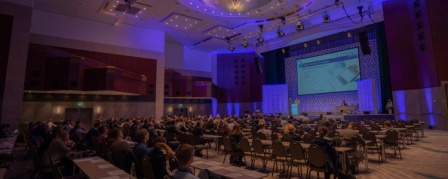 RadTech Europe, the European Association for UV/EB curing technology has concluded its 2019 biennial conference and exhibition. The refreshed format brought together more than 350 professionals from 31 countries, including users of the technology, formulators, suppliers as well as academia representatives, at the Westin Grand hotel in Munich.
RadTech Europe, the European Association for UV/EB curing technology has concluded its 2019 biennial conference and exhibition. The refreshed format brought together more than 350 professionals from 31 countries, including users of the technology, formulators, suppliers as well as academia representatives, at the Westin Grand hotel in Munich.
The 2019 event was the first edition in the new format, with a 2- instead of 3-day programme featuring selection of almost 70 presentations and a compact line-up of 23 premium exhibitors in the tabletop area directly connected to the main conference area. The organisation registered more visitors than at the previous edition in Prague in 2017, and was particularly pleased to welcome a record number of over 50 end-users to this year’s event.
A broad spectrum of topics
Presentations featured the latest trends and developments in areas like photopolymerisation, coatings and adhesives, raw materials, health and safety, sustainability, regulatory affairs, UV-LED, metal coating and 3D printing. Special features included the food packaging seminar (one of the key focus areas of the association in recent years) especially aimed at end-users, as well an introductory course for students and newcomers to the profession of UV/EB curing technology.
“A very important part of our industry”
This year’s Programme Committee chair (and past President of the association) Dawn Skinner of Heraeus (UK) comments: “We are pleased with the industry’s response to the new, compact setup of our event. It is always a challenge to change a proven concept, but we felt that it was time to make the transition to a more contemporary format. This year’s turnout has confirmed that our biennial conference remains an important part of our industry in that it combines solid content with the aspect of connecting expertise and peer networking.”
Showcasing the three pillars of RadTech Europe’s strategy
RadTech Europe President Paul Kelly of Luxsit Ltd (UK) added: “It is our strategy to focus the energy of RadTech Europe on market conversion (towards UV/EB curing technology), education and the opportunity for exchange of knowledge and experience between established professionals. This year’s programme well reflected these three key pillars of our ambition.”
Kelly concludes: “On our way to the next RadTech Europe conference, we will align the efforts of our volunteer workforce towards the confirmation of RadTech Europe as the “go-to” platform for our technology. We will closely examine the outcomes of this conference which has provided a rich library of content to followed up in the coming years in our programmes and webinars.”





























































































